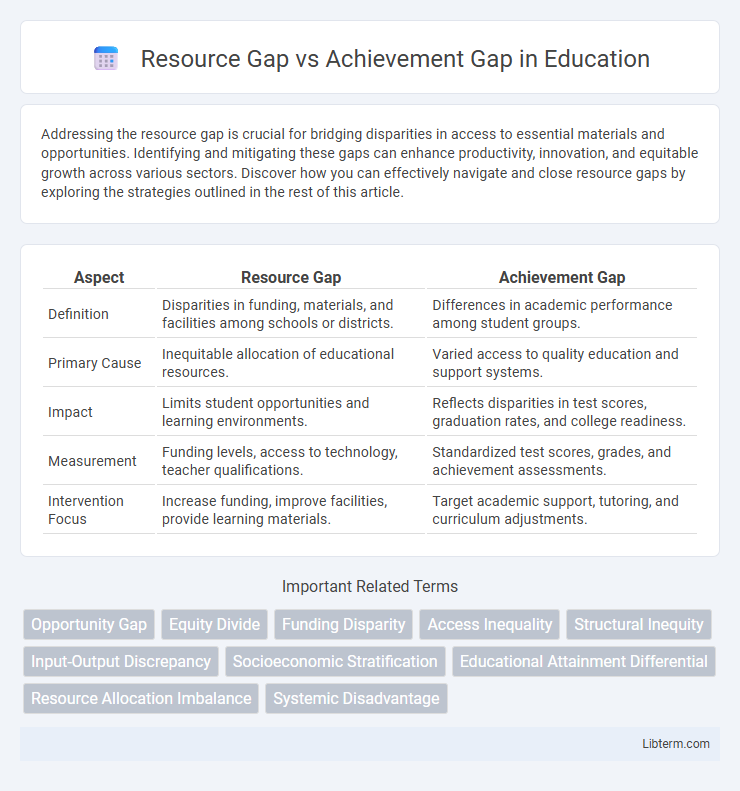Addressing the resource gap is crucial for bridging disparities in access to essential materials and opportunities. Identifying and mitigating these gaps can enhance productivity, innovation, and equitable growth across various sectors. Discover how you can effectively navigate and close resource gaps by exploring the strategies outlined in the rest of this article.
Table of Comparison
| Aspect | Resource Gap | Achievement Gap |
|---|---|---|
| Definition | Disparities in funding, materials, and facilities among schools or districts. | Differences in academic performance among student groups. |
| Primary Cause | Inequitable allocation of educational resources. | Varied access to quality education and support systems. |
| Impact | Limits student opportunities and learning environments. | Reflects disparities in test scores, graduation rates, and college readiness. |
| Measurement | Funding levels, access to technology, teacher qualifications. | Standardized test scores, grades, and achievement assessments. |
| Intervention Focus | Increase funding, improve facilities, provide learning materials. | Target academic support, tutoring, and curriculum adjustments. |
Understanding the Resource Gap
The resource gap refers to the disparities in access to crucial educational materials, experienced educators, and technology between schools in affluent areas and those in under-resourced communities. This gap significantly impacts student learning outcomes by limiting opportunities for academic growth and skill development. Addressing the resource gap is essential for bridging overall achievement disparities and promoting educational equity.
Defining the Achievement Gap
The achievement gap refers to the persistent disparity in academic performance between groups of students, often defined by socioeconomic status, race, or ethnicity. It manifests through differences in standardized test scores, graduation rates, and college enrollment rates. Understanding the achievement gap is crucial for developing targeted educational strategies to ensure equity and improve outcomes for underrepresented students.
Key Differences: Resource Gap vs Achievement Gap
The resource gap refers to disparities in access to educational materials, qualified teachers, and funding between schools or districts, directly impacting the quality of instruction and learning environments. The achievement gap measures the differences in student academic performance, such as test scores and graduation rates, often resulting from underlying resource disparities and socioeconomic factors. While the resource gap highlights structural inequities, the achievement gap reflects the outcome of these inequities on student success.
Causes of the Resource Gap in Education
The resource gap in education stems primarily from unequal funding distribution, often linked to local property taxes that favor wealthier districts. Institutional biases and policy decisions further exacerbate disparities, limiting access to qualified teachers, modern technology, and extracurricular programs. Socioeconomic factors and geographic isolation also contribute, creating significant challenges for under-resourced schools to support student achievement effectively.
Factors Contributing to the Achievement Gap
The achievement gap is influenced by multiple factors including socioeconomic status, access to quality education, and family support systems, which interplay beyond just the availability of resources. Resource gaps manifest as disparities in funding, experienced teachers, and educational materials, but achievement gaps reflect broader issues such as community environment, health disparities, and access to early childhood education. Addressing the achievement gap requires a comprehensive approach that considers both material resources and social determinants of academic success.
Socioeconomic Influences on Educational Outcomes
Socioeconomic influences significantly impact both the resource gap and the achievement gap in education, where students from low-income families often face limited access to quality instructional materials, experienced teachers, and extracurricular opportunities. These disparities in resources contribute directly to lower academic performance and reduced graduation rates among disadvantaged students compared to their higher-income peers. Addressing socioeconomic barriers is crucial to closing both gaps and promoting equitable educational outcomes across diverse communities.
Equity vs Equality in Addressing Gaps
Resource gaps refer to disparities in access to essential resources such as funding, technology, and qualified teachers, while achievement gaps denote differences in academic performance among student groups. Addressing resource gaps promotes equity by allocating support based on individual needs to ensure all students have the opportunity to succeed, contrasting with equality, which provides identical resources regardless of specific barriers. Equity-focused strategies in education aim to close achievement gaps by recognizing and remedying systemic disadvantages rather than applying uniform solutions.
Long-Term Impacts of Resource Gaps
Resource gaps in education, characterized by disparities in funding, facilities, and access to quality teachers, lead to long-term impacts such as reduced academic achievement, lower graduation rates, and limited college enrollment among disadvantaged students. These resource deficiencies perpetuate cycles of poverty by restricting opportunities for skill development and economic mobility over time. Addressing resource gaps is crucial to closing achievement gaps and promoting equitable educational outcomes across generations.
Effective Strategies for Closing the Gaps
Targeted resource allocation, such as equitable funding and access to quality teachers, directly addresses the Resource Gap by providing under-resourced schools with essential tools and materials. Implementing culturally responsive curricula and personalized learning plans helps mitigate the Achievement Gap by fostering student engagement and addressing diverse learning needs. Data-driven interventions combined with community partnerships enhance both gaps by ensuring continuous monitoring and support tailored to specific student populations.
Policy Solutions for Bridging Resource and Achievement Gaps
Targeted policy solutions that allocate equitable funding to under-resourced schools directly address the resource gap, enabling improved educational materials, qualified teachers, and infrastructure. Implementing early intervention programs and comprehensive support services fosters academic achievement by mitigating the effects of socio-economic disparities. Data-driven accountability measures ensure that resources effectively translate into measurable gains in student performance, thereby narrowing both resource and achievement gaps.
Resource Gap Infographic

 libterm.com
libterm.com